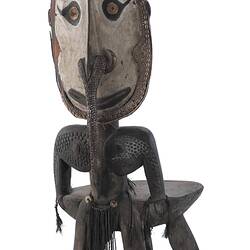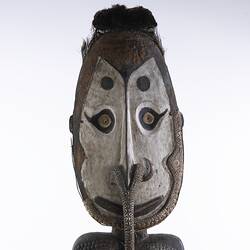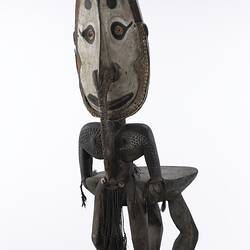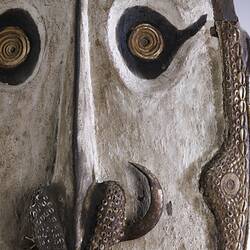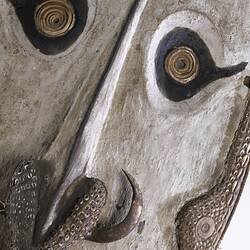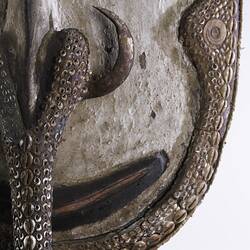Summary
The centre of an Iatmul village of the Sepik River, Papua New Guinea, is the spirit house. It is where objects imbued with spirit are kept, and where men gather to conduct their religion, or simply to gossip and to sleep. These stools, or teket, are the seat for the principal ancestral spirit, who authorises village orators to carry on their debates. Each speaker in his turn holds a bunch of sword-like cordyline palm leaves, which he strikes against this seat in calling on the names of the ancestors and emphasising significant points. Such debates are often carried on for hours underlining the importance attached to this event.
Physical Description
A stool made from a single piece of wood with a standing figure forming the back. The half-sphere base has five legs, two belonging to the figure, and the round seat connects to its waist. The male figure has a skirt of multiple strands of fibre (or string) attached to a waistband with a shell on either side. It also has a string bracelets and anklets. Clay inlaid with cowrie shells is embedded around the sides and jaw of the face (like a beard). The face is painted with natural pigments and has shells for eyes. A pig tusk projects from nostrils and the nose extends into a trunk with animal head at the end that has clay inlaid with shells. An incised pattern extends across the chest onto the upper arms.
Significance
This is an orator's stool from Kanganaman village and would have been located in the spirit house in the centre of a Iatmul village on the Sepik River. It was the seat for the principal ancestral spirit that authorises village orators to carry on their debates.
More Information
-
Object/Medium
Stool
-
Maker
-
Locality
-
Exhibition Collection Management
690 mm (Length), 700 mm (Width), 2080 mm (Height)
-
Keywords
-
Collection Names
-
Type of item
-
Discipline
-
Category
-
Collecting Areas

